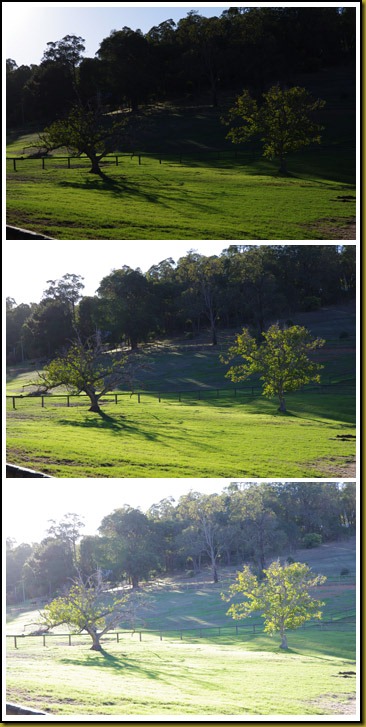Three-shot HDR Using Unified Color

Single-shot HDRs are done by extracting three separate JPG pictures from a single HDR. Typically the extracted pictures are about +/- 1.5 stops above and below the set exposure for the picture. This is generally about as much room as you have to move within the RAW.
Today, as it is a long time since I actually went out and took any pictures, I decided to go out and take some pictures so I could demonstrate a ‘normal’ three shot HDR with +/- 1.7 stops above and below the set exposure.
At left are the three shots with the 1.7 stops under-exposed shot at the top, the correctly exposed picture in the middle (based on what the camera thought was correctly exposed), and the 1.7 stops over-exposed picture at the bottom.
It is about 4:30 p.m., it is mid-Autumn here in Australia, and the falling sun is just out of shot off to the left.
Above is the HDR produced using Unified Color’s HDR Express. This is the automatic HDR with none of the HDR Express special effects applied. You can check my previous posts on single-shot HDRs to see some of the pre-set effects (styles) possible using HDR Express. All that has been done here apart from merging the HDR together is to crop a bit off the bottom to get rid of part of that railing in the bottom left corner.
Below, for the purposes of comparison, is the untouched out-of-the-camera middle shot from the three shot set above. I have given it the same border treatment for a better comparison.
While this is only what might be referred to as a vanilla HDR merge it has still improved the picture significantly. Notice the extra detail in the trees up on the hill. Also the two subject trees look to me much more like I remember them looking compared to how they look in the non-HDR middle picture. Even the green grass in the foreground looks much more like I recall the actual scene looking when I stopped to take these pictures.

I always work with the camera set to aperture preferred so the shutter speed was varied and not the iris size, which is very important when doing HDR work. If the iris/aperture changes then the depth of field changes, which is not good for the HDR merge (things get blurry).
The shot at right is a crop directly from the HDR shown above. Don’t you just love the resolving power of modern DSLR lenses? This is the Pentax 18–135 zoom. Okay ... there is a degree of blurring going on here due to camera shake for sure, but then the subject area was 200 metres or so away and I did do the three shots hand holding the camera.
For those that like to know the numbers the shots were taken with the Pentax 18–135 zoom at 53m using f7.1 set on ISO 200. According to the EXIF data the shutter speed for the three shots was 1/60th, 1/200th, and 1/640th. The focus point and the centre-weighted light reading point was the left one of the two subject trees.



